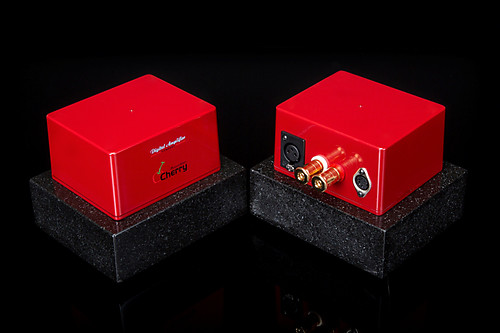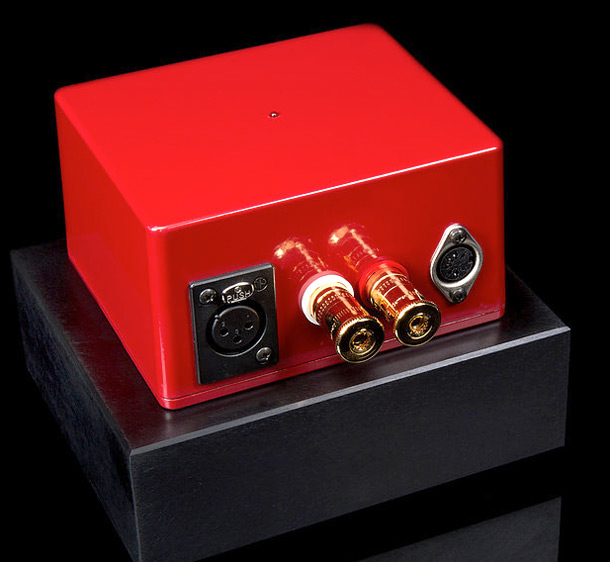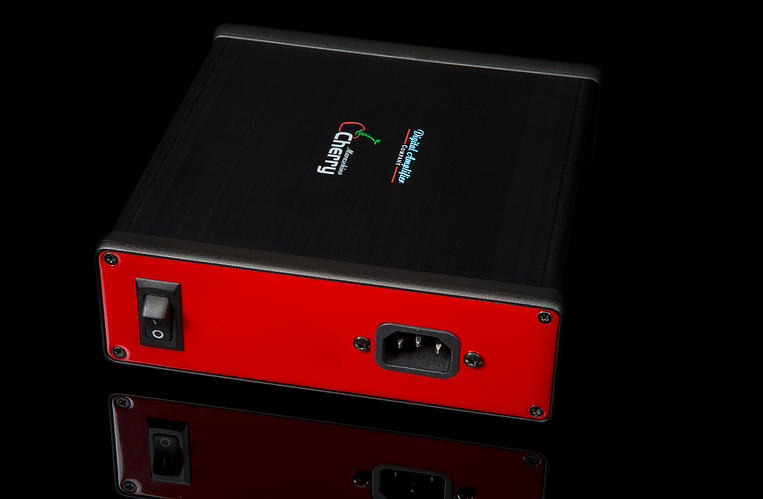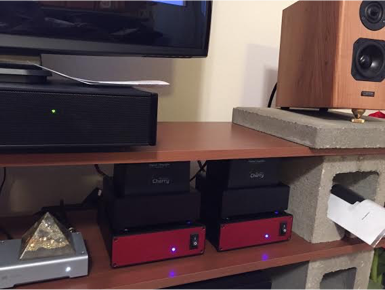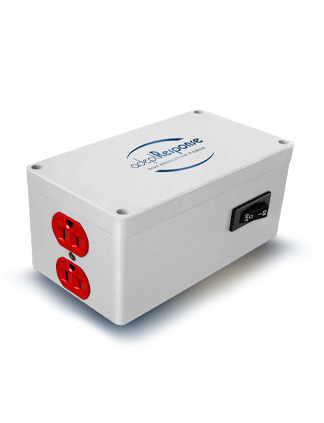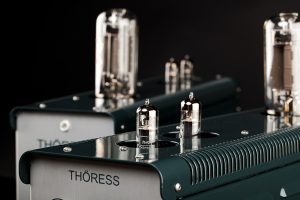As class-D amplifiers continue to evolve, it's exciting to have the opportunity to test examples such as Digital Amplifier Company's small monoblocks, dubbed the Maraschinos. While each Maraschino is very compact—6 inches wide, 6 inches deep, and a 5 inches tall, they are surprisingly solid and heavy—these amps should not be taken, well...lightly.
Their physical size-to-sonic-bodyslam ratio makes them a bit like the Daniel Bryan of the amp world. The Maraschinos deliver a hefty 200 watts into 8 ohms and 400 watts into 4 ohms. According to DAC's literature, the Maraschinos can also handle loads in the 2-ohm range with a staggering 800 watts. So at this price point—$3300 per pair—you get a lot of watts per dollar.
The company logo is elegantly silk-screened onto the metallic fascia and the small power LED indicates on or off operation. That's about it as far as things to look at. Although plain looking, there's in fact nothing wrong with the cosmetics whatsoever. Nor with the weight-to-size ratio that's unexpectedly high. It's simply the case that a platinum card DarTZeel shopper probably won't notice the Maraschinos. Their loss.
The amplifier enclosures use a solid base of natural stone or aluminum, and Sorbothane™ feet to isolate the Maraschino from vibration. The weighty base holds the Maraschino in place even when connected to heavy speaker wires via the luxurious gold WBT binding posts that are pure audio jewelry. Your choice of red or black top is standard. Tommy O'Brien, President of Digital Amplifier company, states that other colors can be had for a fee and several choices for optional base materials are available as well, including marble and granite. He is available to speak with all potential buyers to create a fully customized set of amplifiers.
The ground potential of the Maraschino amplifier is locked to the preamp's ground, preventing noise and hum. This makes selecting a suitable preamplifier a very important step. I had mixed luck with preamplifiers during the evaluation period, with my passive Schiit pre not working at all. I settled on utilizing the dithered software volume attenuation within Pure Music software for all listening with these amps and it worked perfectly. I recommend contacting Mr. O'Brien to discuss preamplifier suitability before buying.
Output impedance is kept very low across the entire audio band and beyond. Most amplifiers have bass phase shift due to AC coupling, but the Maraschino DC couples the signal throughout for no bass phase shift and response down to zero Hertz. On the high end of the spectrum, the Maraschino reaches all the way up to 100kHz. Maraschino also provides"green operation" with an automatic standby mode; decreasing power consumption to around 1W after several minutes of no audio (mute). The amps wake up as soon as an audio signal is present again.
Each KING Desktop Maraschinos are powered by a unique external 60V power supply with proprietary umbilical that connects it to the power amp.
The power amps come with a 120V power cord, which I would of course recommend upgrading to a Triode Wire Labs 7+ power cable, like I did.
Listening
I was fortunate enough to be able to use the Maraschinos to drive a range of loudspeakers during the review period—from ultra low efficiency desktops to extremely sensitive horn floor standers. Speakers used for evaluation include Dayens Tizo monitors (82.5dB), Sonus Faber Olympica III (90dB and possibly the most beautiful things I've ever seen) and Klipsch Synergy tower speakers (96dB)
I'm first in line to believe that low-power amps tend to be quicker, more transparent, and refined than muscle-bound equivalents. At close to ten times my Dayens Ampino's power, the Maraschinos break with that rule. Class D amps tend to get less respect than their class A and A/B elders, often for good reason. Here too the Maraschinos fail to conform. The Maraschinos are delicious. Tubes sound more romantic and musical. Put in such terms, the first part vis-à-vis the Maraschinos is true. But the second? Isn't music by its very definition musical? If so, do we need enhancements or alterations before music is made musical? This line of conversation quickly gets philosophical. Again I'll be first to admit that I enjoy the temporal relaxation tubes can give, which shed a certain metronomic quality for freer looser breath. But this quality can be injected with line-level tubes if one needs it. What's most essential for speaker drive is raw power. Control. Broad bandwidth. Low noise. Low distortion. Here the Maraschinos categorically eclipse most tube amps, certainly those which are anywhere near it on price.
If this is beginning to sound like an endless worship of neutrality, then maybe that's the case. But neutrality eludes description. Only recording engineers have a chance of actually knowing it by direct comparison to the live feed. To describe the Maraschinos, I'd focus on aspects like unwavering image lock, realistic sizing, articulated depth layering, clear sound staging, absence of hardness, and etch despite very high precision.
By comparison to my lower powered Ampino power amp, I feel the difference as a sense of quickening, greater clarity, tighter but better defined bass, more open treble, greater immediacy, higher jump factor aka suddenness, and ultimately greater dynamics. The Maraschinos exert iron-fisted control for no dynamic bleaching. That's where speaker selection comes in.
With the Marachino KINGs, I heard my beloved Dayens Tizo monitors spring to life like never before. They absolutely basked in the power. They loved every second of it. On the polar opposite of the price spectrum, the Sonus Fabers were a match made in audiophile dreams. These amplifiers are no softening agent and for a warmish speaker like the Sonus Faber Olymipca III; they proved to be the perfect counterpoint. The 200 watt Maraschinos are enough to go plenty loud on virtually any speaker, and paired with they Olympica III's they provided some of the sweetest sounds I've ever had the privilege of hearing. If you can….you should. However, the super efficient Klipsch towers were a little too shrill and piercing for my taste when paired with these monoblocks. Is that the amps fault? I'm inclined to think not. It is my belief that Klipsch designed the Synergy series around the assumption that they would be used with inferior, lower bandwidth amps, and inexpensive home theater receivers. So I think the fumble on that matchup goes to the speakers.
With suitable speakers, the first thing you notice sonically about the Maraschinos is the non-fatiguing way they present music. Regardless of musical genre, the Maraschinos avoid stridency. They render jazz, classical, rock, and electronica very well, allowing the listener to sit back and enjoy the musical experience without the"wince factor" that some equipment creates. I put these amps through the"Four Davids" test—that is, listening to Crosby, Brubeck, Bowe and Arkenstone—and the music retained the heart of the performances without harsh sonic artifacts.
The Maraschinos bring to life the guitar plucks on"Give My Love to Rose," from Johnny Cash's American IV, with delicacy and richness. While amps tend to place the vocals properly into the mix and render the song's emotional content very well, accurately portraying the age and gravelly roughness in Cash's voice.
They also render John Coltrane's saxophone with clarity and grace. Those who have sat near a live saxophone performance know that the sound can have a natural sharpness in some cases. The Maraschinos manage to reveal the detail of Coltrane's performance without adding any harshness beyond that already inherent in the recording. Through the Maraschinos, the jazz legend's album Blue Train is both engaging and relaxing.
Fans of electronica know that bass punch and depth are necessary to get people out on the dance floor. DAC claims a frequency response of DC to 100kHz for the Maraschinos, plus or minus 3dB. As I'm not able to get the dog next door to howl at notes beyond the upper range of my hearing, I can't verify sound above 20kHz. I can say with conviction, however, that the bass indeed goes very deep. In addition to low-frequency test tracks verifying an audible and tangible 20Hz rumble in my room, Peter Gabriel's excellent "Growing Up" illustrates the Maraschinos ability to provide plenty of get-up-and-go.
Recordings of live performances by Morrissey offer varying degrees of audio quality, so I rely on the recently released BluRay, despite it not including some of my favorite songs. Here, the Maraschinos do an excellent job of revealing the dynamic contrasts of the various instruments on stage with Moz. Guitar notes dance through the air with delicacy; cymbals have a solid crash and a slow decay; and bass lines are easily identified. In a recording like this, adequate power is necessary to get the heft of the performance through my speakers—and the Maraschinos do not disappoint.
Conclusions
In this light, could they actually be the world's best tiny monoblock amps ever made? That's the kind of grand statement that fights stem from. So in the name of peace and love, I'll simply say that I don't know of another set of $3300 mono amps with this type of true power, grip, lucidity, and refinement. Not even close.
What I can't get my head around? That they sell on Amazon. What's the chance of someone seeing it there even recognizing what they truly had were they to get one? Then again, they do have three Amazon reviews—all of which are five stars—so what do I know?
For everything that they do so well with no major shortcomings to speak of, the Maraschinos provide great value. DAC made smart decisions in the designing and voicing of these amps. They offer durable ease of use, stellar energy efficiency, enjoyable and non-fatiguing portrayal of music, the power needed to drive challenging speaker loads, and a neutral sonic profile that renders all types of music quite well.
At $3300 per pair, the Marachinos are certainly worth an audition. Despite the fact that the excellent packaging could easily bear a return shipment—I doubt they'll go back. For this price, I think you'll find that this pair of amps is an absolute knockout.
Digital Amp Company




